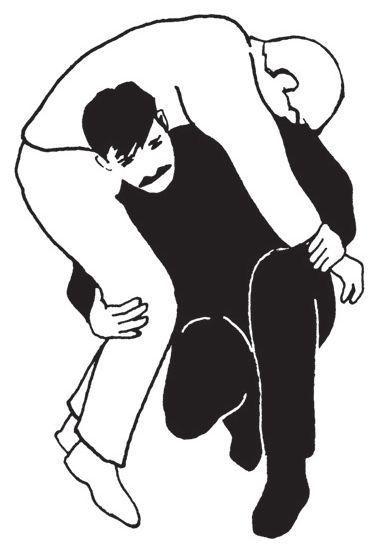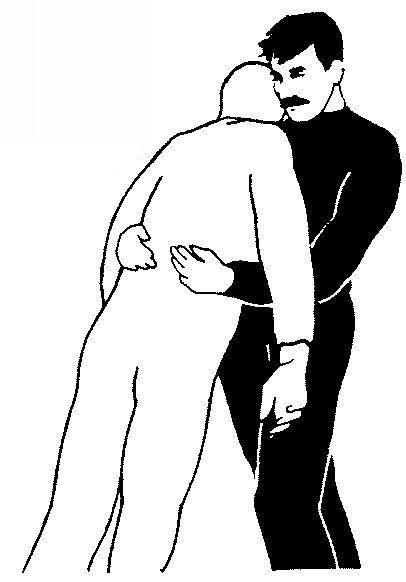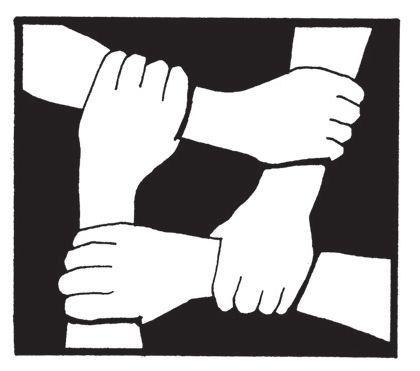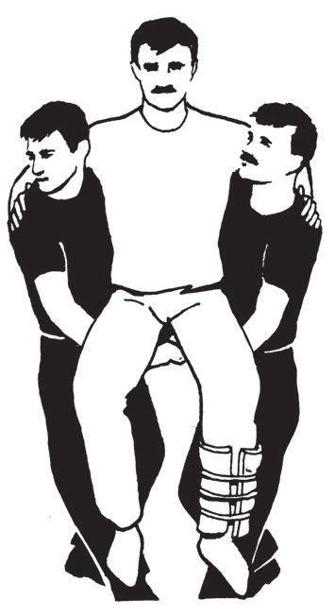SAS Urban Survival Handbook (58 page)
Read SAS Urban Survival Handbook Online
Authors: John Wiseman
Tags: #Health & Fitness, #Reference, #Survival, #Fiction, #Safety, #Self-Help, #Personal & Practical Guides, #General, #Survival Skills

If you need to rescue an unconscious person, the safest and easiest way of moving them is the fireman’s lift. If you cannot manage, and the danger is great from smoke/fumes or flames, drag the person out of the building any way you possibly can!

1
Lean forward slightly and at the same time lift casualty’s arm over your shoulder and behind your head. Bend over until your right shoulder is at the same level as the casualty’s stomach.

2
Pull the casualty across your back and shoulders-they will take the weight. If it helps, you can rest on your right knee. Your right arm around or between the casualty’s legs will add support.

3
Taking the weight on your right shoulder, reach around the casualty’s legs to hold his/her wrist, and lift. Push yourself up by pressing down with your left hand on your left knee.

4
Standing up, you can now proceed to take the casualty to safety. The position of the casualty’s head is not ideal if there are head or neck injuries, but there may be no choice.


Lifting an inconscious casualty
If necessary, turn the casualty face down. Kneeling at the head, slip hands under the shoulders to the armpits. Firstly, lift the casualty into kneeling position. Then, standing yourself, lift the casualty upright. Proceed with fireman’s lift, 1-4.
TWO-PERSON SEATS
Two people can easily carry even a heavy casualty to safety by making a ‘chair’. Holding your left wrist with your right hand, reach under the casualty and grip the other carrier’s right wrist with your left hand (shown). The casualty holds both carriers’ shoulders for support.


If the casualty has suffered arm injuries, carriers will have to provide extra support. Carriers should clasp each other’s forward hands under the casualty’s thighs, using padding in a hook-like grip (shown). At the same time, reach behind the casualty’s back and either grip clothing or the other carrier’s upper arm.


TRAPPED!
If your escape route to the ground floor is blocked and there is no way that you can escape from the building safely, you must try to
raise the alarm
and
signal for help
—position yourself where you can be rescued, as far from the fire as possible. Protect yourself from the actual fire and smoke and fumes.
- ◑ Go to a room (which is not on fire) with a window. Close doors, windows and fanlights.
- ◑ If you cannot get out onto a balcony or roof, slow the approach of the fire. If there is water in the room, douse the walls and door—this will slow the flames. Block any gaps or holes that will let smoke into the room. Use rolled-up cloth or blankets (wet, if possible) to block cracks and openings round doors and windows.
- ◑ Open a window and attract attention by shouting or waving.
- ◑ In an office building, throw paper out of the window—it should catch the eye of someone below.
- ◑ If a window is sealed and cannot be opened use a chair or your feet to knock out the glass. If you have to use your hands wrap them in cloth or a garment for protection. Use your elbows if you are wearing long sleeves.
- ◑ Break double- or treble-glazed windows with a hammer.
- ◑ Laminated glass is difficult to break, but keep trying. Once all the glass is broken, it may push out of the frame.
- ◑ If there is a balcony or flat roof that you can reach safely, get out on to it and close the window or door behind you.
JUMPING
- ■
If you are on the first floor and the ground below is soft it may be safe to drop. Throw pillows or bedding on to the ground to break your fall. - ■
Hang from a window sill or ledge at full stretch. Just before you drop, hold on with one hand and with the free hand push your body away from the wall. Keep your feet and knees together with legs slightly bent, head tightly on chest. - ■
When you let go, relax and try not to resist the ground. Do not jump or spring away. - ■
Don’t try to break a fall with your arms. Use them to protect your head. - ■
If you can make a sheet or curtain rope, this will at least shorten your fall. Make sure it is tightly secured. - ■
Do not jump from an upper storey. It is safer to position and protect yourself properly and await rescue.
- ■
- ◑ If you have to climb through a broken window, knock out jagged glass and place a blanket or clothing over the base.